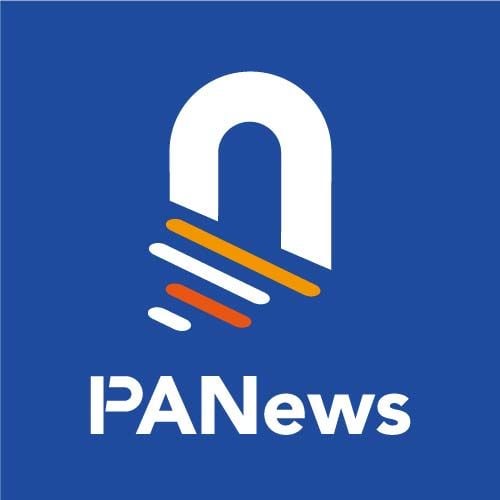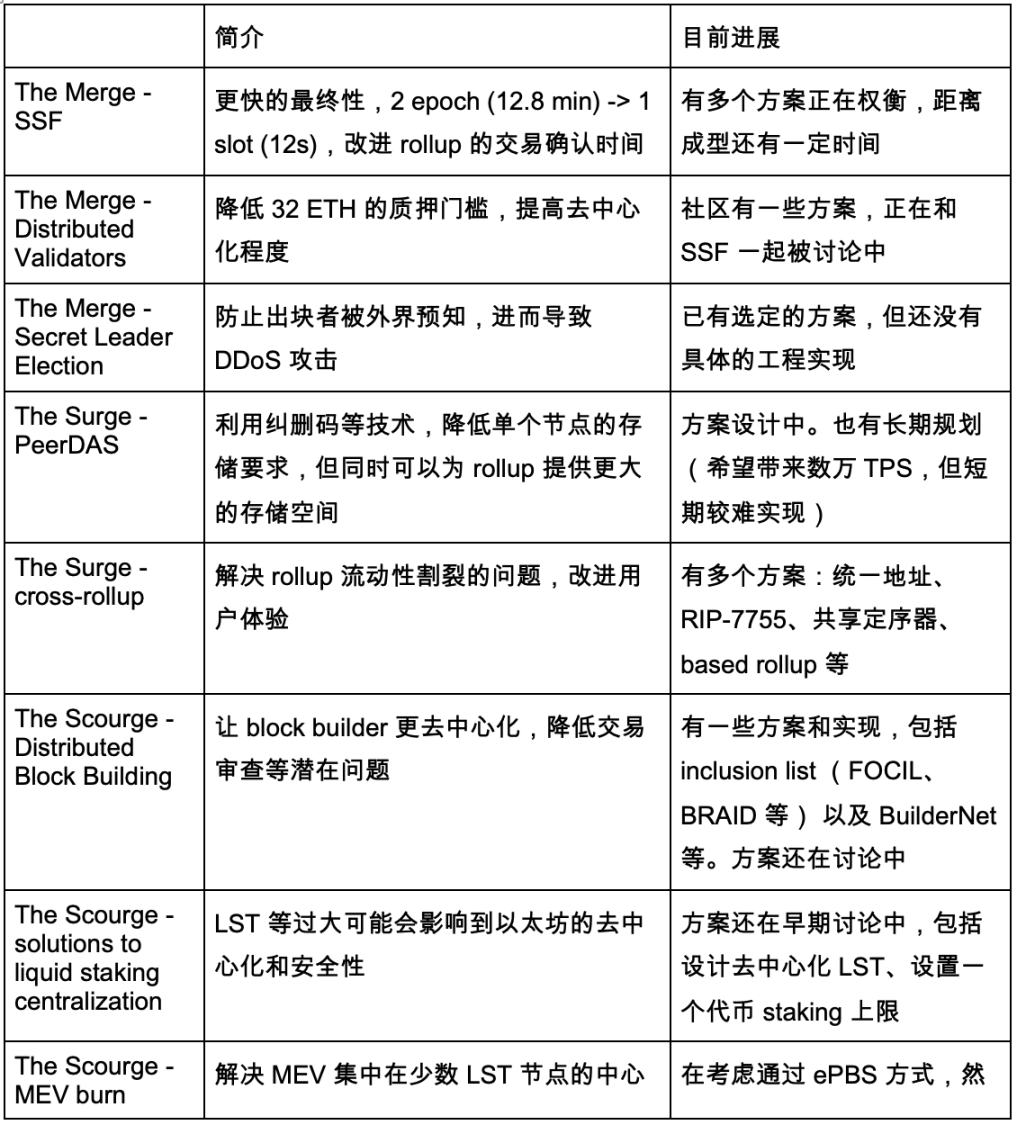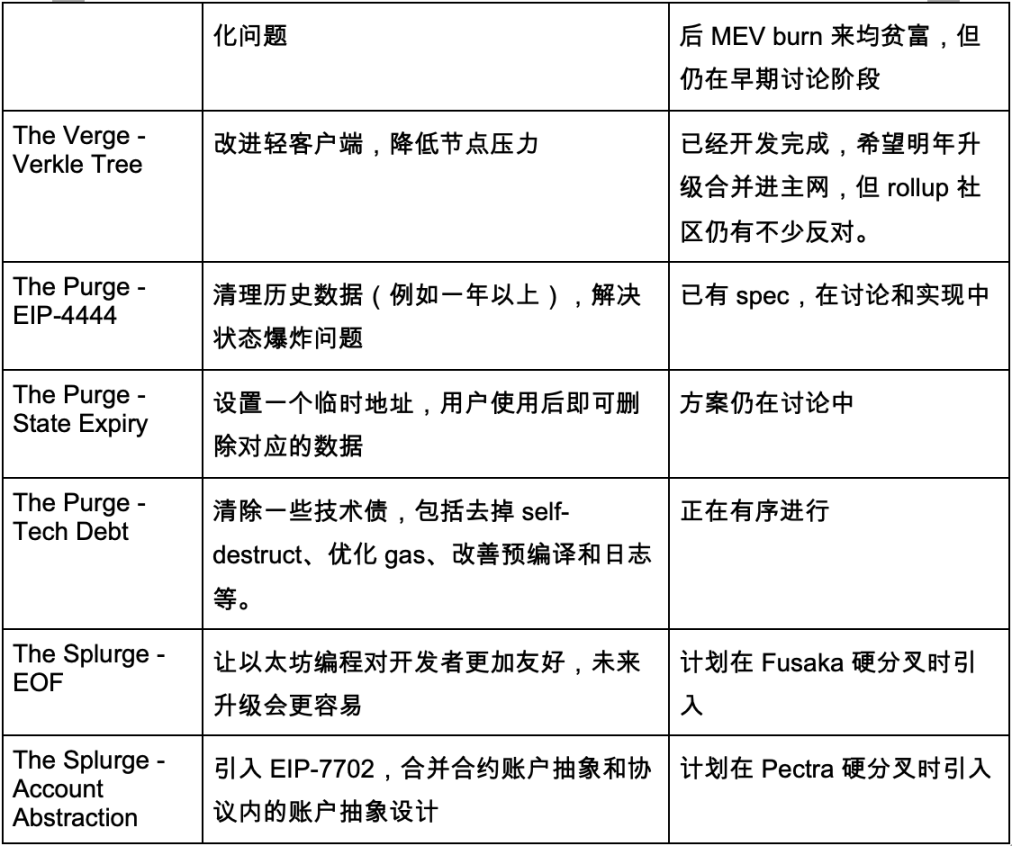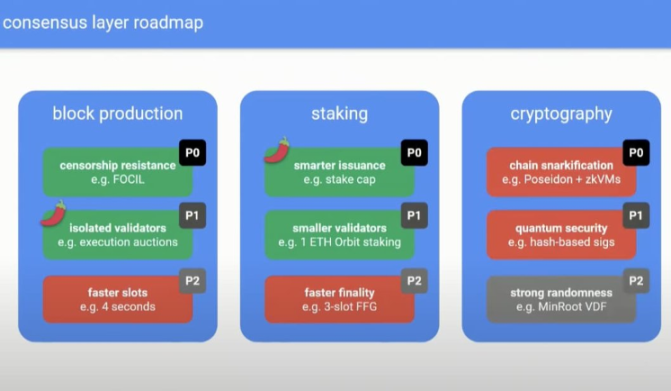Opportunities in the Ethereum Roadmap, DevCon and Pectra Upgrades

Reprinted from panewslab
01/09/2025·1MAuthor: Zeqing Guo, Jeffrey Hu
Looking back at history, it is not difficult to find that many of the cutting-edge technology discussions in the Ethereum developer community have eventually evolved into current daily application products, from DEX and lending to rollup and DA. Of course, this also contains opportunities for investment layout.
So, at this point in time in early 2025, what valuable information can we capture from technical discussions such as Ethereum’s roadmap, recent DevCon, and the upcoming Pectra upgrade early next year? This article attempts to sort out and discuss it.
Ethereum’s roadmap
The Ethereum roadmap has always been an important reference for observing future development directions, including various stages such as The Merge, The Surge, The Scourge, The Verge, The Purge, The Splurge, etc. Vitalik also published intensively in October to introduce the content of each stage. in:
- The Merge: The main completion is the execution layer and consensus layer, thus completing the transformation from PoW to PoS. But The Merge part also includes some improvements in the consensus protocol, including single-slot finality, lowering the validator threshold, etc.
- The Surge: The main discussion focused on future scalability, improving it from the ground up to better serve rollup. Among them, EIP-4844 has been launched, and future key contents include PeerDAS to reduce node pressure and cross-rollup interaction.
- The Scourge: Mainly reduce some problems related to MEV, including excessive concentration of builders and MEV value being captured by large LST.
- The Verge: Including the change of the underlying layer from Merkle tree to Verkle tree and the Snarkization of EVM.
- The Purge: Reduce the pressure on Ethereum node data storage and status maintenance by deleting or archiving historical data. It will also clean up some technical debt.
- The Splurge: Some more cutting-edge improvements, including EVM underlying, account abstraction, and other cryptography applications (VDF, etc.).
In the table below, we excerpt the key improvements in these stages, introduce their main effects, and summarize the current progress.


DevCon
In addition to the roadmap, another information channel worth exploring is the recent Ethereum DevCon conference. Current problems and some possible solutions are discussed.
Perhaps one of the most eye-catching topics at DevCon belonged to Beam Chain. From the slightly joking but inaccurate "Ethereum 3.0", we can also see the community's desire for new development directions in the future. Beam Chain has proposed many underlying improvements, including snarking the underlying layer and improving block generation and staking. But the roadmap will take about 5 years to complete, so it doesn't require much additional attention for the time being.

https://www.youtube.com/watch?v=Gjuenkv1zrw
Rollup-related topics continue to be a hot topic during DevCon. Among them, the most discussed issues are the liquidity fragmentation between rollups and the difficulty in interaction, which affects the user experience. Many speeches and panels have touched on this problem or related solutions. In addition, the current technological maturity of L2 was also discussed at the meeting, because currently only Optimism and Arbitrum have basically entered Stage 1 (licensed fraud proof), while most other L2 projects are still at Stage 0 (centralized upgrade) , no fraud proof, etc.), it needs to be synchronized with the L1 upgrade.
In addition, there were also intensive discussions on chain abstraction, pre-confirmation, cryptography applications, future upgrades, etc. during DevCon. We will focus on the Pectra upgrade content in the next section.
Pectra upgrade
What deserves attention in the near future is the Ethereum Pectra upgrade expected to be completed in 2025 Q1, which will also include a number of related transformations from the bottom layer to the user side.
EIP-7702: AA
The most relevant one for users is EIP-7702. Based on the design of EIP-3074, EIP-4337 has been further developed, giving all EOA accounts the ability to "temporarily" convert to smart contract accounts, which can further improve user experience. (Sign multiple transactions at one time, 0 gas, etc.), but it may also increase security risks such as signature phishing. At the same time, EIP-7702 is also applicable to all EOAs. It takes effect, so wallets and other products should also be modified simultaneously to cope with this upgrade. However, overall, the launch of EIP-7702 will still bring new opportunities to all AA projects. More information can be found in our previous reports.
EIP-7691: Increase blob count
Pectra plans to adjust the target number of blobs per block from 3 to 6, and increase the maximum number of blobs from 6 to 9. Blobs provide cheaper storage space for rollup. Increasing the number of blobs will further reduce the cost of rollup at the expense of increasing node operating costs and enhance Ethereum's DA competitiveness. Therefore, it will further benefit rollup projects. At the same time, the adjustment of the target value and the maximum value also makes the gas drop more quickly when the blob is unused, and the gas rises more slowly when the blob is fully loaded and reaches the maximum limit.
EIP-7251: Increase staking limit
Pectra plans to increase the current staking limit of 32 ETH to 2,048 ETH. Ethereum staking service providers and whales no longer need to divide their ETH into multiple nodes. Instead, they can merge and put them into one node to reduce the number of validators in staking.
future opportunities
All the above technical changes or research discussions may bring some new changes and opportunities. We summarize some of the more focused opportunities below.
Interactivity between Rollups
Whether it is from the roadmap or many sharings at DevCon, we can see that the fluidity, interoperability and interoperability between Layer 2 (rollup) are the most important focus for developers.
Currently, there are different solutions in the community to solve the mobility and interoperability issues between rollups at various levels.
- Based rollup: Since many L2 currently use their own relatively centralized sequencer to implement transaction sequencing, and then publish it to L1, interaction cannot be achieved quickly and timely. One solution is to implement the sequencing function through L1 to ensure the atomicity of interactions between L2 using this sequencing function.
- Shared sequencer: In addition to based-rollup, another implementation method is for L2 to share a set of sequencers to complete interaction.
- Cross-chain intents: In addition to solving the problem from the sequencer level, using intents to meet the needs of cross-rollup is another solution.
Currently, the above solutions are being implemented. For example, the Based Stack proposed by Spire Labs to implement based rollup is expected to be launched in Q1 of 2025; Astria, Espresso and Polygon AggLayer related to the Shared sequencer are being launched and iterated one after another; ERC-7683 was initially used by Unichain, Arbitrum, etc. to solve cross-chain liquidity problems; while Optimism The launched ERC-7802 can implement SuperchainERC20 to support unified asset standards and liquidity transfer within the superchain ecosystem. These different solutions are likely to compete for a winner on the market in 2025.
Account abstraction
Because all EOA account addresses are involved, the activation of EIP-7702 will provide a new opportunity for the AA project. EIP-7702, combined with functions such as chain abstraction and intents, may also build more complex cross-chain or multi-chain interaction functions. However, since the market performance of ERC-4337 has been tepid before, the Pectra upgrade may also be the last opportunity for the AA track to verify PMF.
Therefore, after Pectra is upgraded in the first quarter of next year, teams that participated in EIP-7702 earlier and are prepared, such as Zerodev, may receive a new wave of growth, and the specific effects will be known soon.
cryptography applications
In both the Ethereum roadmap and DevCon discussions, cryptography-related technologies and applications are still a big topic. In terms of technology, zkEVM and zkVM frameworks are gradually maturing, and ZKP combined with MPC, FHE, etc. will likely have more application combination possibilities. In addition, some cutting-edge cryptography technology discussions during DevCon, such as indistinguishable obfuscation (iO), known as the crown jewel of cryptography, may also receive more attention.
In terms of application, cryptography technology will also have many opportunities on the consumer side. Authentication applications including ZK Email (especially implementation based on Aztec Noir) and zkTLS are likely to be more adopted. In addition, recent events such as OFAC's sanctions against Tornado Cash being deemed to be ultra vires may also dispel some concerns about the compliance of privacy-related applications.
Special thanks to Zhixiong Pan and Yan for their review and suggestions on this article!


 chaincatcher
chaincatcher